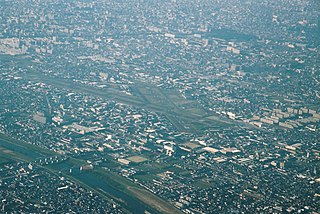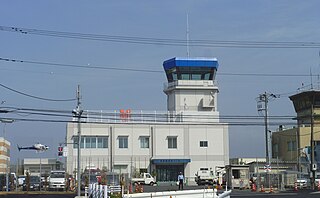| Akasaka Press Center | |
|---|---|
赤坂プレスセンター | |
| Minato, Tokyo, Japan | |
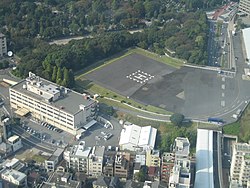 Main building and helipad as viewed from Roppongi Hills (part of Hardy Barracks building visible to left) | |
| Coordinates | 35°39′48″N139°43′32″E / 35.66333°N 139.72556°E Coordinates: 35°39′48″N139°43′32″E / 35.66333°N 139.72556°E |
| Code | HDY |
| Area | 26,937 m2 |
| Site information | |
| Controlled by | United States Army |
| Garrison information | |
| Garrison | United States Army Garrison Japan |
| Airfield information | |
| Identifiers | ICAO: RJ01 |
| Elevation | 97 feet (30 m) AMSL |
Akasaka Press Center (also known as Hardy Barracks and Azabu Heliport) is a facility of the United States Army, Japan located in the Roppongi area of Minato, Tokyo.

United States Army, Japan (USARJ) is a Major Command of the United States Army. It consists of about 2,000 soldiers and is charged, during peacetime, with operating port facilities and a series of logistics installations throughout Honshū and Okinawa. USARJ participates actively with the Japan Ground Self-Defense Force in bilateral training exercises and the development of bilateral plans. It commands and supports United States Army assigned units, attached units, and augmentation forces and employs these forces in support of the commander. USARJ maintains and strengthens the credibility of deterrent power in the Pacific through maintenance of defense facilities, war reserves and operational project stocks. USARJ is headquartered at Camp Zama.

Roppongi (六本木) is a district of Minato, Tokyo, Japan, famous for the affluent Roppongi Hills development area and popular night club scene. A few foreign embassies are located near Roppongi, and the night life is popular with locals and foreigners alike. It is in the central part of Tokyo, south of Akasaka and north of Azabu.

Minato is a special ward in Tokyo, Japan. It is also called Minato City in English.
The facility occupies 3.1 hectares of land in central Tokyo. It houses the Tokyo offices of Stars and Stripes , the Tokyo division of the Office of Naval Research, [1] and the Hardy Barracks, an accommodation facility for military personnel. The base also houses a helipad and gasoline pump. The United States Army has officially stated that the helipad is meant to be used during emergency situations in Tokyo, while the mayor of Minato City has stated that "we have been told in response to inquiries that the details of how the base is used cannot be released publicly." [2]

Stars and Stripes is an American military newspaper that focuses and reports on matters concerning the members of the United States Armed Forces. It operates from inside the Department of Defense, but is editorially separate from it, and its First Amendment protection is safeguarded by the United States Congress, to whom an independent ombudsman, who serves the readers' interests, regularly reports. As well as a website, Stars and Stripes publishes four daily print editions for the military service members serving overseas; these European, Middle Eastern, Japanese, and South Korean editions are also available as free downloads in electronic format, and there are also seven digital editions. The newspaper has its headquarters in Washington, D.C.

The Office of Naval Research (ONR) is an organization within the United States Department of the Navy responsible for the science and technology programs of the U.S. Navy and Marine Corps. In that capacity it funds and collaborates with schools, universities, government laboratories, nonprofit organizations, and for-profit organizations.
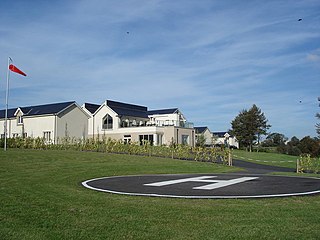
A helipad is a landing area or platform for helicopters and powered lift aircraft.
The heliport is periodically used by civilian helicopters for official purposes such as medical evacuation of patients from the Ogasawara Islands under a 2008 agreement between the US military and Tokyo metropolitan government. [3] [4] Michael Jackson boarded a Black Hawk helicopter from the site in March 2007. [5]

Michael Joseph Jackson was an American singer, songwriter, and dancer. Dubbed the "King of Pop", he is regarded as one of the most significant cultural figures of the 20th century and one of the greatest entertainers. Jackson's contributions to music, dance, and fashion, along with his publicized personal life, made him a global figure in popular culture for over four decades.
The site was previously the base of the 3rd Infantry Regiment, 1st Division, Imperial Japanese Army, one of the units involved in the February 26 Incident of 1936. The unit was sent to Manchuria later that year, and the site then housed units of the Imperial Guard through the end of World War II. The United States military took over the entire site in 1945. [6] A large portion of the facility was returned to Japan in 1962 and used by the University of Tokyo Institute of Industrial Science until 2001; this area is now occupied by The National Art Center, Tokyo and the National Graduate Institute for Policy Studies.

The 1st Division was an infantry division in the Imperial Japanese Army. Its call sign was the Jade Division. The 1st Division was formed in Tokyo in January 1871 as the Tokyo Garrison, one of six regional commands created in the fledgling Imperial Japanese Army. The Tokyo Garrison had responsibility for the eastern region of Honshū, centered on the Tokyo metropolitan area. The six regional commands were transformed into divisions under the army reorganization of 14 May 1888, based on recommendations by the Prussian military advisor Jakob Meckel to the Japanese government.
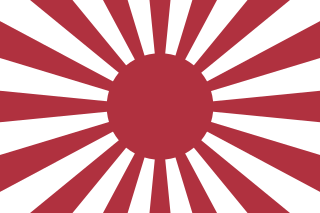
The Imperial Japanese Army was the official ground-based armed force of the Empire of Japan from 1868 to 1945. It was controlled by the Imperial Japanese Army General Staff Office and the Ministry of the Army, both of which were nominally subordinate to the Emperor of Japan as supreme commander of the army and the navy. Later an Inspectorate General of Aviation became the third agency with oversight of the army. During wartime or national emergencies, the nominal command functions of the emperor would be centralized in an Imperial General Headquarters (IGHQ), an ad-hoc body consisting of the chief and vice chief of the Army General Staff, the Minister of the Army, the chief and vice chief of the Naval General Staff, the Inspector General of Aviation, and the Inspector General of Military Training.

The February 26 Incident was an attempted coup d'état in the Empire of Japan on 26 February 1936. It was organized by a group of young Imperial Japanese Army (IJA) officers with the goal of purging the government and military leadership of their factional rivals and ideological opponents.
There has been organized local opposition to the facility since 1967, and both the Tokyo metropolitan assembly and Minato municipal assembly have unanimously resolved to request that the facility be removed. [7]
The facility is located near other US government installations in central Tokyo including the United States Embassy (2.5 km to the northeast) and the New Sanno Hotel (2.2 km to the south).
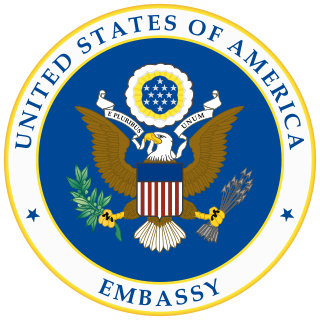
The Embassy of the United States in Tokyo represents the United States in Tokyo, Japan. Along with consulates in Osaka, Nagoya, Sapporo, Fukuoka, and Naha, the Embassy provides assistance to American citizens and residents who live in Japan and issues visas to Japanese nationals, and legal residents in Japan who wish to visit or immigrate to the United States.
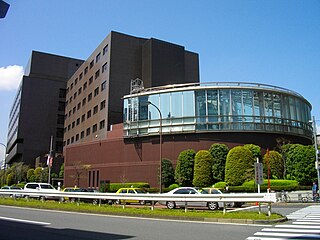
The New Sannō Hotel or New Sannō U.S. Force Center is located in downtown Tokyo. It offers a swimming pool, recreational facilities, a Navy Exchange, and other services designed for military travelers. The hotel is regulated and controlled by the U.S.–Japan Status of Forces Agreement. In addition to active duty and retired U.S. military personnel eligible to use other Armed Forces Recreation Centers, DoD civilian employees duty stationing in Japan, contractors on DoD orders to execute contracts for the U.S. armed forces stationed in Japan, U.S. Embassy Tokyo personnel and individuals administratively attached to U.S. Embassy Tokyo are eligible to use the hotel.





